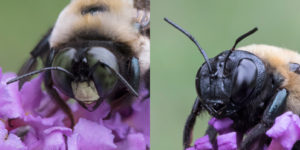THANK YOU for the great info on these cute but annoying creatures who have infested my porch beams…..will spraying insulating foam sealant into the holes do the job of caulking or corks? If so, that would sort of reinforce the holes as well as trap the bees after spraying. What should I do about the holes the bee has already sealed? I assume the wasps loitering around are trying to get to the newly laid eggs at this time of the year and are establishing nests to be near to take advantage of the hatching bees in the fall.
Carpenter bee holes should be sealed with a CORKS or wood dowel and not caulking or expanding foam. The key is using something that seals the hole tight but keeps all the space inside open. This will allow hatching larvae to move about when they come out of their pupae casings. By having access to the entire egg chamber they’ll crawl through the DEMISE DUST and effectively pick up a lethal dose. If you used silicone caulking or expanding foam, they won’t be able to move over the treatment and the net result would be they’ll be forced to drill a new exit hole effectively missing the dust altogether. We see this happen many times when people hire painters or some other exterior finishing company who thinks they’re doing right by sealing the holes. But in the end, this will actually cause more of a problem.
I’m not sure about the “holes that are sealed”; carpenter bees will lay eggs and seal them up with food but again, if the voids of the main nest are left open, the treatment with DEMISE or PYGANIC will get them when they hatch since either dust lasts a long time (which is why it’s the only dust to use for this treatment 🙂
Also, I’m not sure about any wasps that might be hanging around either except that they might be looking to start their own nest like they are here at my house. But if you use the some of the Demise applied to cracks and crevices and then spray with the MAXXTHOR EC discussed in our WASP CONTROL article, you should be able to keep them away too. Lastly, I don’t know of any wasps that feed on carpenter bees and even if they did, it will be a long time before the eggs will be hatching so they’re in for a long wait if that’s why they’re hanging around. My guess is they’re really just looking to make new nests in the same area and are a separate problem altogether.
Here are direct links to the information and products listed above:
Corks: https://bugspray.com/equipment/equipment-plugs/cork-12
Demise: https://bugspray.com/catalog/insecticide/dust/drione-demise-dust-6-oz
Pyganic Dust: bugspray.com/exempt/dust/pest-xempt-dust
Maxxthor: bugspray.com/catalog/insecticide/liquid/maxxthor-ec
Wasp Control: https://bugspray.com/article/wasp.html
Give us a call if you still have questions.
Technical Support
1-800-877-7290
